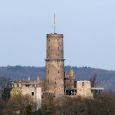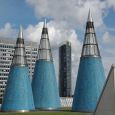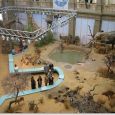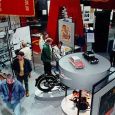Bonn
Advertisement
By Air
Bonn's international airport is Cologne Bonn Airport.The airport handles far more air cargo traffic than passengers, but since the airport has become the hub for a few low-cost air carriers such as Germanwings and TUIfly the airport has seen a nearly two-fold rise in passenger traffic.Outside Europe the airport is a very well kept secret - airlines will often offer on par or better rates to CGN than some of Europe's larger airports like Gatwick, Heathrow, or Charles de Gaulle.Several flights from New York City cost as low as $400 round trip.
By Train
Bonn is connected to three autobahns (federal motorways) and the German rail network.Some InterCityExpress and most InterCity trains call at Bonn Hauptbahnhof whilst the Siegburg/Bonn railway station is situated on the Cologne-Frankfurt high-speed rail line outside of Bonn and serviced by InterCityExpress trains.Local transport is provided by a Stadtbahn (light rail), which also features two lines to Cologne.
Advertisement
Beethoven Monument
is a large bronze statue of Ludwig van Beethoven that stands on the Munsterplatz in Bonn, Beethoven's birthplace.It was unveiled on 12 August 1845, in honour of the 75th anniversary of the composer's birth.Sir George Smart declared the facial features of the statue a good likeness of Beethoven, as did Ignaz Moscheles. But Beethoven's assistant Anton Schindler was contemptuous of it.Carl Heinrich Breidenstein (1796-1876) was Germany's very first professor of musicology. He had held a post at Bonn University since 1823. In 1828 he had first expressed the idea of a monument to Beethoven in his native town. In 1832 he wrote an article suggesting the idea, "or, even better, a living memorial, one dedicated to art, Bildung, education, etc."
Bonn Minster Church
is one of Germany's oldest churches, having been built between the 11th and 13th centuries.At one point the church served as the cathedral for the Archbishopric of Cologne. However, the Minster is now a Papal basilica.Originally the Minster was the collegiate church of Saints Cassius and Florentius, who were Roman legionaries of the legendary all-Christian Theban Legion. The legion's garrison, according to legend, was in the Egyptian town of Thebes. Roman Emperor Maximianus Herculius ordered the legion to march to Gaul and assist in subduing rebels from Burgundy. At some point during their march, the legion refused to follow the emperor's orders either to kill fellow Christians or to worship Maximianus Herculius as a god. As a result, a large number of legionaries were martyred in Agaunum, now named Saint Maurice-en-Valais after Saint Maurice. According to legend, Saints Cassius and Florentius, who were under the command of Saint Gereon, were beheaded for their religious beliefs at the present location of the Bonn Minster.
Godesburg castle
is a castle in Bad Godesberg, a formerly independent part of Bonn, Germany.Built in the early 13th century on the Godesberg, a hill of volcanic origin, it was largely destroyed following a siege in 1583 at the start of the Cologne War.In 1891, the German emperor Wilhelm II donated the castle's ruin to the city of Bad Godesberg.In 1959, the ruin was rebuilt according to plans by Gottfried Böhm, to house a hotel and restaurant. Today, the restaurant is still in operation, but the hotel tract has been divided into apartments.
Bonn Museum of Modern Art
is an art museum in Bonn, Germany, founded in 1947.Its current collection is focused on Rhenish Expressionism and post-war German art.It is part of Bonn's "Museum Mile".The prints collection, featuring around 5,000 works from the 20th and 21st centuries, includes so-called "multiples" by Beuys, illustrated books by Max Ernst, and printed graphics from the Bolliger Collection.The Oppenheim Collection of video art includes works by Dennis Oppenheim, Joan Jonas, Klaus vom Bruch, Marcel Odenbach and Julian Rosefeldt.The Videonale festival of contemporary video art, now based at the Kunstmuseum, has taken place biennially in Bonn since 1984.
Haus der Geschichte
is a modern history museum in Bonn, Germany. Located on the Museumsmeile (Museum Mile), the museum has exhibitions related to German history from 1945 until the present. The museum has a cartoon gallery with over 75,000 political cartoons and caricatures, and in the foyer there are also busts of famous politicians. The museum's collection includes a large part of illustrator Helmuth Ellgaard's works.The Haus der Geschichte is located on Bundesstraße 9 and is part of the Museumsmeile (Museum Mile) in Bonn, which itself is part of the former West German government district. It lies just north of the Kunstmuseum Bonn and the Kunst- und Ausstellungshalle der Bundesrepublik Deutschland, which are also part of the Museumsmeile. The basement of the Haus der Geschichte can be directly accessed from the subway station (Heusallee/Musuemsmeile) below, which is shared by all three museums.
Alexander Koenig Research Museum
is a natural history museum and zoological research institution in Bonn, Germany. The museum is named after Alexander Koenig, who donated his collection of specimens to the institution. The museum was opened in 1934 and is affiliated with the University of Bonn.The museum was founded by the private scholar Alexander Koenig (1858-1940) as a private institute for zoological research and public education. Alexander Koenig, who was born in 1858 as the son of the wealthy merchant Leopold Koenig, began to collect birds and mammals as a boy.He later studied zoology and received a doctorate in natural history in 1884. In the following years he organized and funded several expeditions to the Arctic and Africa and greatly expanded his private collection of specimens.The museum defines its mission as "researching and explaining the diversity of species of Earth".The main exhibition is titled "Unser blauer Planet - Leben im Netzwerk" (Our blue planet - living in a network). It shows complex ecological systems through dioramas of the African Savannah, a tropical rain forests, the polar regions, deserts and Central Europe.Aside from the permanent exhibition the museum houses special exhibitions regularly.
Bonn Women's Museum
is a women's museum in Bonn, Germany. It was founded in 1981 by Marianne Pitzen (the current director) and an interdisciplinary group of working women, and claims to be the first museum of its kind in the world.It hosts temporary exhibitions (over 500 since its founding) and accompanying events, and is run by the society "Women's Museum – Art, Culture, Research".The museum's own collection includes works by Kathe Kollwitz, Katharina Sieverding, Valie Export, Maria Lassnig, and Yoko Ono. It also includes a library with an archive on specialist topics: women in art, history and politics; feminism; cultural politics; art of the 20th and 21st centuries; art since 1945; concrete and constructive art; and architecture and design.The museum is involved with the Gabriele Münter Prize for female artists. It also hosts art and design fairs, and has its own gallery, studios and publishing house.The Frauenmuseum Haus in Berlin is also connected with the Bonn Women's Museum.
Information not available
Information not available
Advertisement








